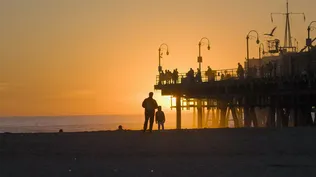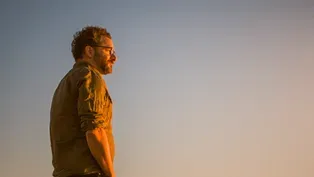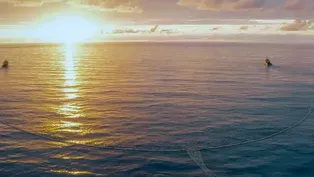
Using Innovative Forms of Design to Transform Tomorrow
Clip: Episode 2 | 9m 18sVideo has Closed Captions
Ari explores the potential of using mycelium-based materials for sustainable products.
Eben Bayer, co-founder of Ecovative, discusses the potential of using mycelium-based materials for sustainable products such as packaging, leather, and even food. This innovative approach significantly reduces resource consumption compared to traditional methods. Bayer's work with mycelium-based materials showcases the potential for sustainable alternatives to conventional practices.
Supported by the Hoveida Family Foundation and The Rosalind P. Walter Foundation.

Using Innovative Forms of Design to Transform Tomorrow
Clip: Episode 2 | 9m 18sVideo has Closed Captions
Eben Bayer, co-founder of Ecovative, discusses the potential of using mycelium-based materials for sustainable products such as packaging, leather, and even food. This innovative approach significantly reduces resource consumption compared to traditional methods. Bayer's work with mycelium-based materials showcases the potential for sustainable alternatives to conventional practices.
How to Watch A Brief History of the Future
A Brief History of the Future is available to stream on pbs.org and the free PBS App, available on iPhone, Apple TV, Android TV, Android smartphones, Amazon Fire TV, Amazon Fire Tablet, Roku, Samsung Smart TV, and Vizio.
Buy Now

What It Means to Be Human
A Brief History of the Future explores the human ability to increase empathy and compassion, what values we are instilling into artificial intelligence technologies, and the need to create both a better world and a better humanity for life to flourish on this planet.Providing Support for PBS.org
Learn Moreabout PBS online sponsorship[wondrous orchestral music] ♪ ♪ - So we're going to head right over here.
- All right.
So I understand this is kind of just a beautiful piece of mycelium basically in a sense.
- Yeah, yeah.
- Like foam-like substance.
What is this?
- This is a leather-like material.
We call it a forager hide.
And it's made from this foam.
We just squish it and tan it and color it and you get something that behaves, looks, and feels a lot like leather.
- So how long will this last?
- So this particular leather-like hide will last for a year or two in this application as tanned.
You could make it last longer by putting other tannery chemistries in, like we use for conventional leather.
So this is where we actually started with something called mushroom packaging.
These are just little corner blocks that would go on a box you might get in the mail, and you know, they've got little breakaways on them.
And then when it gets to you, unlike Styrofoam, big difference is you can just start to break this up.
If you have a compost at home, you can put it in your compost, or you could put it in your yard waste bin.
And within 30 days, this will turn into a nutrient, not a pollutant, in whatever your local ecosystem is.
- What are the biggest problems that you're trying to tackle here?
- The problems that we focus on at Ecovative are around plastic pollution, so this idea that we just created this incredible miracle material that can't degrade, and it's, like, clogging up the lungs and everything of our Earth's ecosystem.
And the other is around animal agriculture, so the mass production of animals for food or materials.
I grew up farming in Central Vermont.
It's fine to raise animals.
Doing it industrially is not ecologically responsible or ethically responsible.
♪ ♪ - Eben sees times of disorder and chaos like these as full of opportunity for transformation.
Rather than simply seeing problems, he sees openings full of potential to invent entirely new ways of doing things that most of us take for granted.
- Welcome to the magic store.
♪ ♪ So what you're seeing here are the aspects of a conventional vertical mushroom farm.
You've got your shelving system here.
You've got your environmental controls.
And now we've modified it to use the soil we use to grow our special forms of mycelium.
And rather than getting a bunch of mushrooms growing out of that bed, you're actually getting a slab of mycelium tissue.
That's really the power.
- There's no wasted space.
- There's no wasted space.
- Because it's sheer mycelium all the way across.
- Yep.
- Like in a slab.
- Well, one of these rooms could produce 20,000 pounds of mycelium.
♪ ♪ So a harvest machine will pull up.
And it comes out like a conveyor.
It comes across and squishes into basically like a pork belly, or a mush belly, we call it.
And then those come off and those go to the bacon facility.
- Wow.
♪ ♪ - So now, this came out in a block.
- Yeah.
- And then you started slicing it?
- It rides along just like a piece of pork belly would be.
So run it through the slicer, you get your slices of bacon, you add salt and sugar and some natural flavorings.
And then at the very end, we put the coconut oil on, which is the fat, because mushrooms don't have any fat in it.
And this is minimally processed.
Sliced and smoked, basically.
- Compare and contrast the inputs that would go into, you know, five pounds of this versus five pounds of bacon from a pig.
- Yeah, so to produce a million pounds of our product takes about an acre of land in one of our vertical farms, and it occurs over about ten days.
To produce the same amount of bacon using a pig, you'd need about a million acres of land.
- Hmm.
- And you would also need to feed that pig high-quality food, so like grains versus woodchips.
And then you have to grow them for a period of six to nine months.
And so in each of those dimensions, land use, the input material, and the time frame, we're massively, like by an order of magnitude, improving the equation.
- Mm-hmm.
♪ ♪ Tastes like bacon.
Now tell me where does this go.
Because so far, we've heard about packaging, right?
And obviously, there's food, and you've mentioned leather.
- Yeah.
- Where do you take this?
- My dream is we grow everything.
You know, I think we can grow almost everything around us from the buildings to the medicines we need to the food we eat.
And we'll do that through structural materials, nutritional materials, and even things that might be alive when you use them.
- Such as?
- Well, you could imagine a building that senses the environmental conditions within it and maybe even releases beneficial compounds to, like, clean the air.
You can imagine buildings that an earthquake develop cracks.
And in those cracks, there are like embedded little water balls that break open.
And the fungus is not dead but is dehydrated, which it can do, and it'll start growing and seal up all those cracks.
Mushrooms are uniquely situated to save the world.
- What Eben and his team are doing here is inspiring and it gives me a renewed sense of possibility for the kind of futures we can choose to create in this moment.
♪ ♪ Here in New York, an architect named Bjarke Ingels is working with a similar perspective to reimagine the cities in which we live.
- I think maybe the best way to explain what's so special about architecture and the power of design is that the Danish word for design is formgivning, which literally means form-giving.
When you design something, you're giving form to that which has not yet been given form.
In other words, you are giving form to the future.
So when you're designing a place or a building, you are giving form to a little part of the world that you would like to find yourself living in in the future.
♪ ♪ - How do you think about the moment of time that we're in right now?
It's kind of chaos and flux.
And a lot of people will want to look backwards, or others will want to stick their head in the sand to keep what they have.
How do you think about this moment?
- We're living in a time where a lot of technologies are bringing possibilities to the table that we have never been even close to before.
And I sense that this innovation that has been maybe locked in virtual in the last few decades has finally arrived in physical space.
And maybe give you one example.
The building we designed in Copenhagen called CopenHill is the cleanest waste-to-energy power plant in the world.
The steam that comes out of the chimney is actually cleaner than the air of Copenhagen.
Suddenly, the power plant no longer had to be some ugly, dirty, polluting eyesore.
It could actually be a welcoming, inclusive environment.
We could make the facade into the tallest man-made climbing wall in the world and we could turn the roof into an alpine ski slope.
So it's an idea we call hedonistic sustainability, that the sustainable building or the sustainable city is not only better for the environment, it's also much more enjoyable for the people that get to inhabit it.
- A lot of times, when people hear the term sustainability or even regenerative, they think, "Something's going to be taken away from me.
"It's not going to be as fun.
I'm not going to be as happy.
I'm going to lose all these things."
That's not the way you think about it.
- 23 years ago, we opened the Copenhagen Harbour Baths, a simple floating structure that extends the life of the city into the water around it.
On opening day, it became so clear that the clean port is not only nice for the fish, it's actually amazing for the people that live in that city, and this idea that the sustainable city is not only better for the environment, it's much more enjoyable for the people that live in it.
Like half of the Copenhageners commute by bicycle, not because it's environmentally friendly but because it's the most enjoyable and effortless way to move around the city quickly.
So in that sense, we just keep reminding ourselves that there is a better and more enjoyable way of doing it.
And I think the benefits of a sort of environmentally friendly city is that it is greener and cleaner and more enjoyable.
♪ ♪ - Tell me about the cities of the future.
Where are we going?
Where do we need to go?
What does it look like?
- If you would return to Manhattan in 10 or 20 or maybe 50 years, you might see streets that entirely become almost like linear parks woven together in both directions of Manhattan.
People can walk and play where you used to have traffic and parked cars.
You might have different kinds of personal mobility also taking over whole areas.
Our cities will really become greener and more enjoyable, which will make them more walkable and more bikeable.
So I think a lot of the dichotomy between the city and the countryside, you're going to get much more interesting blends.
The city isn't the way it is because it has to be.
The city is the way it is because that's how far we've gotten.
And if we would like to ask more of our city or if we would like our city to accommodate another kind of life than what it used to, we actually not only have the possibility, we actually have a responsibility to make sure that our city fits with the way we want to live.
Video has Closed Captions
How do we make sense of today’s exponential rate of change and disruption? (30s)
How Moments of Complexity Offer Opportunities for Change
Video has Closed Captions
Ari explores how moments of tremendous change offer the opportunity for tremendous growth. (6m 11s)
Providing Support for PBS.org
Learn Moreabout PBS online sponsorshipSupported by the Hoveida Family Foundation and The Rosalind P. Walter Foundation.
















